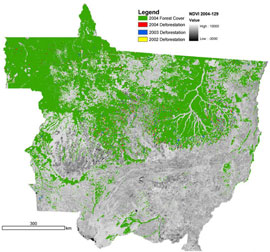Brazil claims soy and beef not responsible for Amazon deforestation
Brazil claims soy and beef not responsible for Amazon deforestation
mongabay.com
October 26, 2006
Brazil rejected claims that soybean farms and cattle pasture were destroying the Amazon rainforest, according to a report from Reuters.
At the opening of an organic food products fair in Sao Paulo, Agriculture Minister Luis Carlos Guedes Pinto said that only 0.27 percent of Brazil’s soybean crop is grown in the Amazon region, while less than 1.5 percent of Brazil’s beef for export comes from the rainforest.
Brazil is the world’s biggest beef exporter and number 2 soy exporter after the United States. During the 2005-2006 growing year, Brazil produced a record 53.4 million tonnes of soybeans.
 Deforestation? What Deforestation?. Cattle pasture in the Amazon. Photo by Rhett Butler. |
According to Reuters, “Guedes said that Brazil farmed 62 million hectares (153 million acres) and could cultivate an extra 50 million hectares by using degraded pasture without ‘cutting down a single tree.'”
While Guedes’ figures on soy and beef production may be accurate, some experts would disagree with his contention that these activites are not responsible for deforestation in the region. Last month NASA researchers published a study showing that forest clearing for large-scale agriculture has recently become a significant cause of deforestation in the Brazilian Amazon. The study, published online in the September 14, 2006 edition of the Proceedings of the National Academy of Sciences, found that in 2003 more than 20 percent of the forests in the state of Mato Grosso were converted to cropland, suggesting that the recent expansion of mechanized cropland in the region is contributing significantly to deforestation.
The findings seemed to confirm the suspicion that Brazil’s soybean production is impacting the Amazon and followed a controversial Greenpeace report which accused fast-food chain McDonald’s of underwriting deforestation in the Amazon through its purchase of soy-based animal derived from soybeans grown in the Amazon Basin. The charges led the company to launch an investigation into Greenpeace’s claims and helped trigger a two-year moratorium by Brazilian soy crushers and exporters on trading soybeans grown on newly deforested lands in the Amazon basin.
“Soy farming is having a huge impact in the Amazon right now, for three reasons,” said William F. Laurance, president of the Association for Tropical Biology and Conservation (ATBC) and a senior staff scientist at the Smithsonian Tropical Research Institute, in an earlier interview with mongabay.com. “First, industrial soy farmers are themselves clearing a lot of forest. Second, soy farmers are buying up large expanses of cleared land from slash-and-burn farmers and cattle ranchers, and the displaced farmers and ranchers often just move further out into the forest, maintaining a lot of pressure on frontier areas. Finally, the soy farmers are a very powerful political lobby that is pushing for major expansion of roads, highways, river-channelization projects, and other transportation that will criss-cross large expanses of the Amazon. This infrastructure is acting like Pandora’s box–it is opening up the frontier to spontaneous, unplanned colonization and exploitation by ranchers, farmers, hunters, and illegal gold miners.”
Much of the soy produced from the Amazon is grown in the cerrado, a tropical savanna-like ecosystem that neighbors rainforest areas. Guedes’ assertion that Brazil could cultivate an extra 50 million hectares without further deforestation may refer to further expansion in the cerrado as well as developing previously deforested lands. Brazil has plenty of cleared land available: since the close of the 1990s alone the Brazilian Amazon has lost about than 150,000 square kilometers of rainforest. In total around 18 percent of the Amazon has been cleared. Nevertheless, deforestation rates in the region have fallen by nearly 40 percent since peaking in 2004. Falling commodity prices and increased enforcement efforts are credited for the drop.
This article used information from a Reuters report as well as previous mongabay.com articles.
